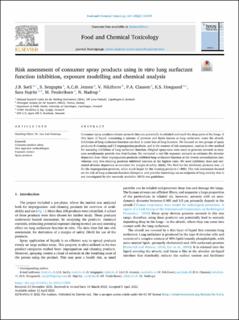| dc.contributor.author | Sørli, J.B. | |
| dc.contributor.author | Sengupta, S. | |
| dc.contributor.author | Jensen, A.C.O. | |
| dc.contributor.author | Nikiforov, Vladimir | |
| dc.contributor.author | Clausen, P.A. | |
| dc.contributor.author | Hougaard, K.S. | |
| dc.contributor.author | Højriis, Sara | |
| dc.contributor.author | Frederiksen, M. | |
| dc.contributor.author | Hadrup, N. | |
| dc.date.accessioned | 2022-07-04T08:56:52Z | |
| dc.date.available | 2022-07-04T08:56:52Z | |
| dc.date.created | 2022-05-19T14:30:54Z | |
| dc.date.issued | 2022 | |
| dc.identifier.citation | Food and Chemical Toxicology. 2022, 164, 112999. | en_US |
| dc.identifier.issn | 0278-6915 | |
| dc.identifier.uri | https://hdl.handle.net/11250/3002536 | |
| dc.description.abstract | Consumer spray products release aerosols that can potentially be inhaled and reach the deep parts of the lungs. A thin layer of liquid, containing a mixture of proteins and lipids known as lung surfactant, coats the alveoli. Inhibition of lung surfactant function can lead to acute loss of lung function. We focused on two groups of spray products; 8 cleaning and 13 impregnation products, and in the context of risk assessment, used an in vitro method for assessing inhibition of lung surfactant function. Original spray-cans were used to generate aerosols to measure aerodynamic particle size distribution. We recreated a real-life exposure scenario to estimate the alveolar deposited dose. Most impregnation products inhibited lung surfactant function at the lowest aerosolization rate, whereas only two cleaning products inhibited function at the highest rates. We used inhibitory dose and estimated alveolar deposition to calculate the margin of safety (MoS). The MoS for the inhibitory products was ≤1 for the impregnation products, while much larger for the cleaning products (>880). This risk assessment focused on the risk of lung surfactant function disruption and provides knowledge on an endpoint of lung toxicity that is not investigated by the currently available OECD test guidelines. | en_US |
| dc.language.iso | eng | en_US |
| dc.rights | Navngivelse 4.0 Internasjonal | * |
| dc.rights.uri | http://creativecommons.org/licenses/by/4.0/deed.no | * |
| dc.title | Risk assessment of consumer spray products using in vitro lung surfactant function inhibition, exposure modelling and chemical analysis | en_US |
| dc.title.alternative | Risk assessment of consumer spray products using in vitro lung surfactant function inhibition, exposure modelling and chemical analysis | en_US |
| dc.type | Peer reviewed | en_US |
| dc.type | Journal article | en_US |
| dc.description.version | publishedVersion | en_US |
| dc.rights.holder | © 2022 The Authors. Published by Elsevier Ltd. | en_US |
| dc.source.pagenumber | 11 | en_US |
| dc.source.volume | 164 | en_US |
| dc.source.journal | Food and Chemical Toxicology | en_US |
| dc.identifier.doi | 10.1016/j.fct.2022.112999 | |
| dc.identifier.cristin | 2025714 | |
| dc.relation.project | NILU: 120089 | |
| dc.source.articlenumber | 112999 | en_US |
| cristin.ispublished | true | |
| cristin.fulltext | original | |
| cristin.qualitycode | 1 | |

